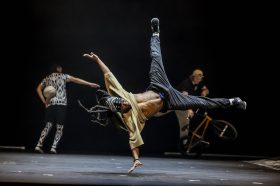Understandably, the arts are abuzz with commentary around yesterday’s (30 January) revelation of Revive: a place for every story, a story for every place – Australia’s next National Cultural Policy. While the sector is still digesting what the announcements may mean for them, a number of peak organisations have offered their responses.
ArtsHub takes a look at that first sweep of opinions.
MEAA – Media, Entertainment and Arts Alliance
The MEAA was a strong advocate for the sector – and especially the gig economy associated with the arts – during the pandemic, pushing for greater support. Today it said Revive was, ‘a major show of faith’, and ‘delivered confidence to arts workers’ after ‘years of wilful neglect’.
MEAA Chief Executive Erin Madeley continued: ‘Revive provides a solid framework for the arts going forward, and it recognises the central role that the arts and arts workers play in our national story and as a major part of the economy.
‘[It] is a refreshing change to have a government that recognises that cultural and creative work is a professional activity that must be underpinned by enforceable fair pay and conditions, including safe and inclusive workplaces.’
MEAA Federal President Simon Collins said that ‘the success of this policy will depend on how it is implemented, including how arts funding is allocated in the future’.
Live Performance Australia (LPA)
Richard Evans AM, President of LPA – the peak body for the live arts and entertainment industry – said: ‘Across the board, the policy is a strong vote of confidence in Australian creative talent and enterprise.’
LPA Chief Executive Evelyn Richardson added the policy provides the ‘kick-start our industry has been looking for’, adding that the organisation, ‘strongly endorses the broader remit for the Australia Council and its renaming as Creative Australia, an approach we have advocated for several years’.
‘It better reflects the contemporary workings of the cultural and creative industries and the range of interdependencies across both the not-for-profit and commercial sectors,’ Richardson continued.
‘The Creative Australia model also acknowledges the significant contribution of the commercial sector which supports around two-thirds of audience attendance and revenue,’ she said.
On top of celebrating a First Nations-led strategy and the establishment of Music Australia, LPA also paid a nod to the promise to, ‘deliver a triennial State of Australian Culture Survey to help measure impact of the policy’.
‘A key issue that has not been substantively addressed in detail in the policy are the critical skills and training needs for the arts and entertainment industry. Achieving and sustaining the ambition of the policy will require a larger, skilled industry workforce, which has been profoundly impacted by the pandemic,’ Richardson said. ‘There is much more work to be done in this area.’
Australian Publishers Association (APA) and National Writers Centre Network (NWCN)
Both the APA and the NWCA have applauded the commitment of $19.3 million in new funding through Writers Australia (located within the rebranded Australia Council), to ‘grow local and international audiences for Australian books’.
CEO of APA, Michael Gordon-Smith, said: ‘Establishing Writers Australia is the most significant development in national literary policy since the formation of the Literature Board in 1975. It begins to address the difficulties and lack of planning over the past decade when authors, publishers and literary infrastructure were not given sufficient priority.’
The new Funds recognise the risks publishers take to bring Australian works to local readers and to international markets.
Michael Gordon-Smith, CEP, APA
His view was echoed by Jessica Alice, CEO of Writers SA and spokesperson for the NWCN: ‘This is a turning point for literary policy and represents a new level of commitment by a federal government to improve the working conditions and wages of writers,’ adding that Revive is ‘genuinely exciting’.
Gordon-Smith said publishers also welcomed the emphasis on First Nations creators, saying that the Government’s actions are ‘timely’. He gave particular mention to the announcement of a Poet Laureate, and digital lending rights in boosting the earning of publishers and authors. ‘The new Funds recognise the risks publishers take to bring Australian works to local readers and to international markets,’ said Gordon-Smith.
National Association for Visual Artists (NAVA)
NAVA Executive Director Penelope Benton said: ‘Importantly, the new policy’s endorsement of NAVA’s voluntary Code of Practice for Visual Arts, Craft and Design is a win for our sector. Mandating the Code in its entirety would have been better, but this is a great start.’
She continued that the Government’s plans, through the policy, to include Award coverage of the arts sector and minimum standards as part of the upcoming Review of Modern Awards, was welcomed. ‘While the policy falls short of answering the call of over 7200 visual arts, craft and design practitioners who signed for the expanded recognition of art as work through an industrial Award, NAVA will continue to advocate for legislated and enforceable minimum employment and payment standards,’ said Benton.
With regard to access, Chair of the NAVA Board, Clothilde Bullen made the point: ‘Whilst it will be important to watch how the policy interacts with new federal budgetary measures to better support art institutions in terms of resourcing, it is clear that the policy understands the work necessary to ensure that independent, disabled, culturally diverse, historically marginalised and regionally and remotely-based artists, and those who have previously been significantly underserved by federal funding support, are seen and will have access facilitated.’
She added: ‘First Nations First offers a firm infrastructure to complete the necessary work on enshrining protections for First Nations artists nationally to protect art styles and Indigenous Cultural and Intellectual Property.’
‘The actions outlined in Revive are a terrific starting point,’ concluded Benton. ‘We also call for a commitment to support the new policy with a ten-year plan from all political parties.’
A New Approach (ANA)
Kate Fielding, CEO of Australia’s leading arts and culture think tank ANA, said Revive offered ‘a meaningful step towards Australia fulfilling its creative promise’.
‘We see it as an important foundational platform that the sector, working alongside government, can use to achieve the policy, performance and funding goals we all agree are critical. Now the work must begin on the actions needed to harness that potential,’ Fielding continued.
She added (which felt silently underscored) that with ‘thoughtful and collaborative implementation and investment,’ the National Cultural Policy can deliver opportunities for cultural experiences and creative expression.
Arts Law Centre of Australia
Robyn Ayres, CEO Arts Law, started by acknowledging that ‘the Australian arts sector has been underfunded and under-valued for close to a decade now’, adding that Revive is a ‘welcome and much-needed reversal of these years of neglect’.
‘Strong leadership on arts and cultural policy has been missing from the Australian Government agenda for many years now,’ said Ayres. ‘We are excited to see the Albanese Government step up and acknowledge the value of our arts and cultural sector.’
Among the list of merits Arts Law Centre of Australia recognised as wins in the policy was ‘an artist-first policy and we are excited to see this reflected in the Revive policy with a focus on the ‘centrality of the artist’, and a focus on Aboriginal and Torres Strait Islander arts and culture ‘as a cornerstone of the First Nations First pillar of the Revive Policy’.
Jo-Anne Driessens, Artists in the Black Coordinator at Arts Law, added: ‘Aboriginal and Torres Strait Islander artists are essentially our cultural keepers and truth-tellers. We all must continue to support the self-determination of the people who are entrusted with cultural stories about our people and country.
‘We are excited to see Indigenous Cultural Intellectual Property (ICIP) protections feature prominently in the new policy and welcome the Government’s commitment to developing and implementing ICIP laws,’ an outcome of many years of advocating by the organisation.
Ayres added: ‘ICIP relates to culture more broadly than just the visual arts and Aboriginal and Torres Strait musicians, dancers, performers, writers, game designers and cultural practitioners of all kinds deserve legal protection.’
APRA AMCOS
The CEO of Australia’s largest music industry body, APRA AMCOS (Australasian Performing Right Association and Australasian Mechanical Copyright Owners Society), Dean Ormston said the injection of $70 million to establish Music Australia is a first in Australian history and that a cross-portfolio, strategic and long-term relationship has been adopted.
‘This is a profound vote of confidence in the cultural, economic and social potential of Australian music,’ he said. ‘Australia now has the potential to go from a music nation to a music powerhouse.’
Ormston added that over-regulation and COVID-19 had threatened the viability of the sector. ‘To reverse this trend, the industry will require a national catalyst to support existing venues and encourage new venues.’
It was a view supported by APRA Chair Jenny Morris: ‘This announcement cannot be underestimated. For the last century Australian contemporary music has been pretty much absent in cultural policy development… The next 10 years will be critical if Australia is to realise future job creation and build skills in music – one of the fastest-growing and most competitive global industries at the forefront of cultural expression, community building, innovation and economic growth.’
She also celebrated the establishment a Centre for Arts and Entertainment Workplaces, that ‘addresses many of the fears and frustrations of music industry workers who face systemic discrimination, bullying, harassment or assault’.
But Morris added a note of warning: ‘For the screen sector, we support the requirement of a significant level of investment by streaming services in local screen content. We urge the government to ensure these measures include commitments to local screen music composition and a framework to support the development of local intellectual property.’
Australian Recording Industry Association (ARIA)
ARIA CEO, Annabelle Herd, said: ‘It is fantastic to see contemporary music front and centre of the new National Cultural Policy’, and a ‘focus on growing export and audience development’ with a whole-of-government approach.
Herd said the biggest challenge faced is, ‘cutting through and finding an audience for new Australian music when 100,000 new songs are uploaded to streaming services every day, while listening to older “catalogue” music remains so popular,’ adding that Australia is facing a crisis in streaming.
‘We thank the government for acknowledging the need for greater support of Australian commercial music as a business that is facing key issues surrounding discoverability and export,’ adding it was a ‘fantastic first step… There is a lot of work to do and the detail behind today’s announcement will be crucial to our success, but this truly is a great start.’
Regional Arts Australia (RAA)
As the national voice for arts in regional Australia for 80 years, RAA celebrated the ongoing uplift to the Regional Arts Fund (which it manages) of $8.5 million over four years.
Executive Director Ros Abercrombie said RAA ‘commends the government for their commitment’, and said the increased investment ‘benefits short- and long-term professional development and capacity building programs, and the development of new works across all arts forms, through regional, rural and remote Australia.’
Australian Live Music Business Council (ALMBC)
‘Although we need to wait till the May budget to see the full offer, it is clear that this Federal Government is listening and responding. We welcome the return of $200 million to the Australia Council For The Arts (now rebranded as Creative Australia), especially following the controversies of the RISE Funding program,’ said a formal statement. They also welcome the creation of Music Australia.
‘Finally, we are very relieved to see the long-awaited introduction of local content requirements for streaming platforms – the benefits of this will move across all Australian creative sectors, including music creation, synching and more,’ added chairperson Stephen Wade.
Chamber of Arts and Culture WA
Describing the policy as ‘positive’, Executive Director of the Chamber, Kim Jameson said: ‘This is a positive move forward for an industry that has been in the wilderness for many years,’ continuing, ‘The ‘Revive‘ policy shifts discussion of the arts from an economic rhetoric to a more holistic
approach.’
‘Revive’ begins to plug policy gaps and allocates $286 million over four years alongside a
clear, defined series of actions which set the tone for a transparent and accountable
government agenda.’
The organisation paid a particular nod to the First Nations First pillar, and welcomed the additional policy commitments ranging from an Arts and Disability Policy Plan that will sit within Australia’s Disability Strategy 2021-31, and a Multicultural Framework Review.
Symphony Services Australia
Sophie Galaise, Chair for the organisation, said: ‘We note the emphasis on collaboration across portfolios. This is something the orchestras have supported for some time.’
She continued: ‘The fourth Pillar of the Policy, Strong Cultural Infrastructure, recognises and will provide support for cultural institutions of all sizes. As major employers of Australian musicians, conductors, composers and arts workers the orchestras welcome additional investment that will support our ongoing ability to play an important role as large performing arts companies and critical enabling arts infrastructure.’
Galaise described the policy as a ‘blueprint’, adding, ‘we recognise some of the core actions in the five-year plan are yet to be funded.’





